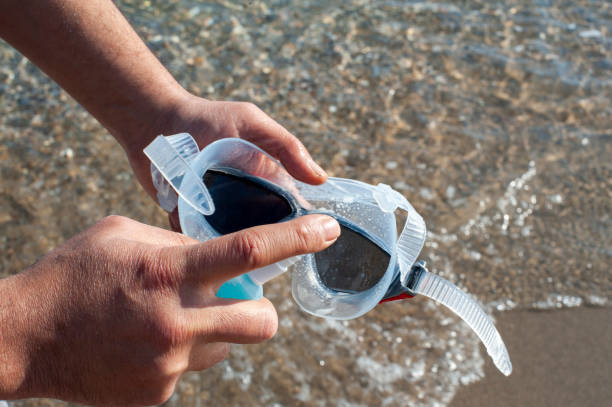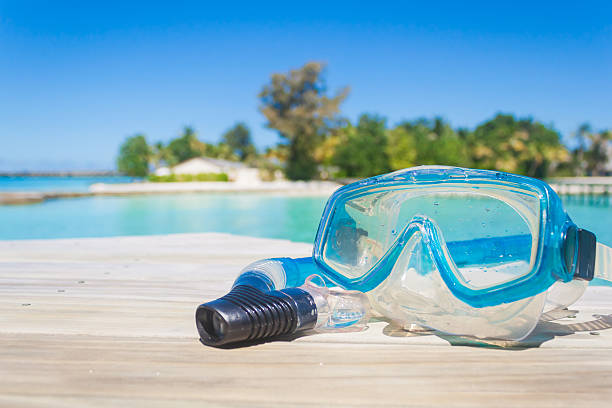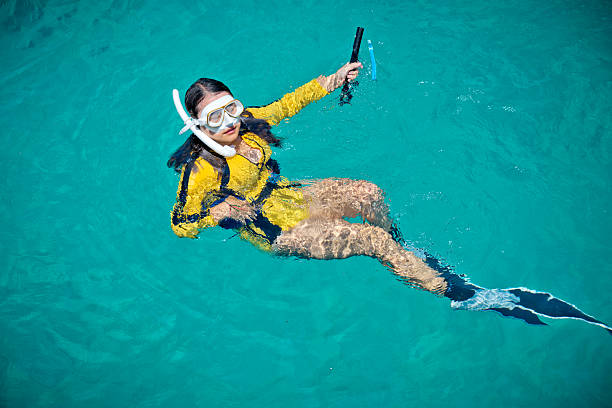Vous êtes-vous déjà demandé comment se compose votre maillot de bain préféré ? Eh bien, vous êtes au bon endroit ! Les maillots de bain existent en différentes matières, chacune adaptée à vos besoins et préférences. Découvrons ensemble de quoi sont faits les maillots de bain et ce qui les rend si uniques.

Évolution historique des matériaux des maillots de bain
Les maillots de bain ont connu une transformation remarquable au fil des siècles, reflétant l'évolution des normes sociales, des technologies et de la science des matériaux. Voici un aperçu de l'évolution des matières des maillots de bain :
Les premiers maillots de bain
Au XIXe siècle, les maillots de bain étaient bien loin des modèles élégants et fonctionnels que nous connaissons aujourd'hui. Les premiers maillots étaient confectionnés dans des matières lourdes comme la laine et le coton. Ces tissus étaient choisis pour leur sobriété et leur durabilité, mais ils étaient loin d'être pratiques. Imaginez-vous entrer dans l'eau vêtue d'une robe en laine : inconfortable et encombrante, n'est-ce pas ?
Pourquoi la laine et le coton ?
- Modestie: À cette époque, la pudeur était une préoccupation majeure. La laine et le coton offraient une couverture complète, conforme aux normes sociales de décence.
- Disponibilité: Ces matériaux étaient facilement disponibles et relativement peu coûteux, ce qui les rendait accessibles au grand public.
Défis :
- Poids: Lorsqu'ils sont mouillés, la laine et le coton deviennent extrêmement lourds, ce qui fait de la natation une activité pénible.
- Temps de séchage : Ces matériaux prenaient beaucoup de temps à sécher, ce qui provoquait souvent une gêne.
Innovations du milieu du XXe siècle
Le milieu du XXe siècle a marqué une période charnière dans l’histoire du maillot de bain, portée par les progrès de la technologie textile et une évolution vers une natation plus récréative.
Tissus synthétiques :
- Nylon: Développé dans les années 1930 et introduit dans les maillots de bain dans les années 1940, le nylon a révolutionné le monde du bain. Léger, il séchait rapidement et offrait un meilleur ajustement et un meilleur confort que la laine ou le coton.
- Polyester: Autre merveille synthétique, le polyester est devenu populaire dans les années 1950 et 1960. Il était durable, résistant au rétrécissement et à l’étirement et conservait bien sa forme.
Impact de la mode et des médias :
- L’essor d’Hollywood et sa représentation de vêtements de plage glamour ont influencé la perception du public et la demande de maillots de bain élégants.
- Le bikini emblématique, introduit dans les années 1940, a popularisé la tendance vers des modèles plus révélateurs du corps, nécessitant l'utilisation de matériaux plus souples et plus ajustés.
Tissus modernes
Aujourd'hui, les maillots de bain allient style, fonctionnalité et technologie. Les matières modernes sont conçues pour améliorer la performance, le confort et la durabilité, répondant à une variété d'activités et de préférences de natation.
Synthétiques avancés :
- Élasthanne (Lycra) : Connu pour son élasticité exceptionnelle, le spandex est souvent mélangé à d'autres tissus pour offrir un ajustement parfait et une excellente liberté de mouvement.
- PBT (polytéréphtalate de polybutylène) : Utilisé dans les maillots de bain de compétition, le PBT est très résistant au chlore et à la décoloration, offrant durabilité et performances durables.
- Néoprène : Caoutchouc synthétique utilisé dans les combinaisons de plongée, le néoprène offre une isolation thermique et une flottabilité, ce qui le rend idéal pour les activités en eau froide.
Focus sur la durabilité :
- Matériaux recyclés : Avec une conscience environnementale croissante, de nombreuses marques utilisent désormais du nylon et du polyester recyclés fabriqués à partir de filets de pêche, de bouteilles en plastique et de chutes de tissu mis au rebut.
- Fibres naturelles : L’expérimentation avec du coton biologique, du chanvre et d’autres matériaux biodégradables offre des alternatives écologiques, bien que celles-ci soient moins courantes.
Matériaux courants pour les maillots de bain

De quoi sont faits les maillots de bain ? Maillots de bain Aujourd'hui, les maillots de bain sont fabriqués à partir de matériaux variés, chacun possédant ses propres propriétés, répondant à des besoins et des préférences spécifiques. Examinons de plus près certains des tissus les plus courants utilisés dans les maillots de bain.
Nylon
Le nylon est un polymère synthétique devenu incontournable dans la fabrication de maillots de bain. Reconnu pour sa résistance et son élasticité, il offre de nombreux avantages aux nageurs.
Propriétés du nylon
- Léger: Le nylon est incroyablement léger, ce qui le rend confortable à porter sans sensation d'alourdissement.
- Durable: Ce tissu est connu pour sa robustesse et sa capacité à résister à l'usure, garantissant ainsi une durée de vie plus longue de votre maillot de bain.
- Élastique: L'excellente élasticité du nylon lui permet de s'étirer et de s'adapter au corps, offrant un ajustement parfait.
- Séchage rapide : L’une des caractéristiques remarquables du nylon est sa capacité à sécher rapidement, ce qui est parfait pour les activités de natation.
Avantages du nylon
- Confort: La texture lisse du nylon est confortable contre la peau, réduisant les irritations et les frottements.
- Ajuster: Sa nature élastique assure une conception ajustée qui met en valeur la silhouette du nageur.
- Versatilité: Adapté aux maillots de bain récréatifs et compétitifs, le nylon est un choix polyvalent pour de nombreux types de maillots de bain.
Polyester
Le polyester est un autre matériau populaire dans les maillots de bain, apprécié pour sa durabilité et sa résistance aux facteurs environnementaux.
Propriétés du polyester
- Résistant au chlore : Le polyester résiste bien au chlore, ce qui en fait un choix privilégié pour les nageurs en piscine.
- Résistant aux UV : Ce tissu offre une excellente protection contre les rayons UV, empêchant la décoloration et la dégradation du tissu.
- Durable: Le polyester est connu pour sa résistance et sa résilience, garantissant des performances durables.
Avantages du polyester
- Longévité: Les maillots de bain en polyester sont moins susceptibles de perdre leur forme ou leur élasticité au fil du temps, offrant ainsi une durée de vie plus longue.
- Faible entretien : Le polyester est facile à entretenir et à maintenir, résistant à de multiples lavages sans usure significative.
- Options respectueuses de l’environnement : Le polyester recyclé, fabriqué à partir de bouteilles en plastique post-consommation, offre une alternative durable avec les mêmes excellentes propriétés.
Spandex (Lycra)
Le spandex, également connu sous le nom de marque Lycra, est une fibre synthétique réputée pour son élasticité exceptionnelle.
Propriétés du spandex
- Très élastique : Le spandex peut s'étirer jusqu'à cinq fois sa longueur d'origine et revenir à sa forme d'origine, offrant une flexibilité inégalée.
- Lisse et doux : Ce tissu est doux au toucher, offrant confort et réduisant les frottements contre la peau.
- Léger: Malgré son élasticité, le spandex est léger et n'ajoute pas de volume au maillot de bain.
Avantages du spandex
- Liberté de mouvement : L'extensibilité du spandex permet une gamme complète de mouvements, ce qui le rend idéal pour les nageurs actifs et les athlètes de compétition.
- Coupe confortable : Le tissu épouse parfaitement les formes du corps, garantissant un ajustement confortable et sûr.
- Conception améliorée : Souvent mélangé à d'autres matériaux, le spandex améliore les performances globales et l'ajustement du maillot de bain.
Tissus spécialisés pour maillots de bain
En plus de ces matériaux courants, il existe des tissus spécialisés conçus pour répondre à des besoins et des préférences spécifiques.
PBT (polybutylène téréphtalate)
- Résistant au chlore : Le PBT est très résistant au chlore, ce qui le rend idéal pour une utilisation régulière en piscine.
- Conservation de la forme : Ce tissu conserve sa forme et son élasticité au fil du temps, même en cas d’exposition fréquente à l’eau chlorée.
- Séchage rapide : Le PBT sèche rapidement, ajoutant au confort et à la commodité des nageurs.
Néoprène
- Isolation thermique : Le néoprène est un caoutchouc synthétique qui offre une excellente isolation thermique, ce qui le rend parfait pour les combinaisons de plongée et les activités en eau froide.
- Flottabilité: Ce tissu ajoute de la flottabilité, aidant les nageurs à rester à flot plus facilement dans l'eau.
- Durabilité: Le néoprène est très durable et résistant aux dommages causés par l’eau et le soleil.
Tissus résistants au chlore
- Durabilité améliorée : Ces tissus sont spécifiquement conçus pour résister aux effets dégradants du chlore, prolongeant ainsi la durée de vie du maillot de bain.
- Conservation de la couleur : Les tissus résistants au chlore conservent leur couleur et leur apparence plus longtemps, même en cas d’exposition fréquente à l’eau chlorée.
Matériaux de maillots de bain durables

Avec la prise de conscience croissante des enjeux environnementaux, la demande de maillots de bain durables a explosé. Les marques se tournent de plus en plus vers des matières éco-responsables pour réduire leur empreinte environnementale. Plongeons dans l'univers des matières durables pour maillots de bain et découvrons comment elles font sensation dans l'industrie de la mode.
Nylon recyclé
Le nylon recyclé est une excellente option pour des maillots de bain durables. Ce matériau est fabriqué à partir de déchets pré-consommation, comme des chutes de tissu, et de déchets post-consommation, comme des filets de pêche et des tapis usagés.
Propriétés du nylon recyclé
- Durabilité: Conserve la résistance et la résilience du nylon vierge.
- Douceur: Offre une sensation douce et confortable contre la peau.
- Flexibilité: Maintient une excellente élasticité, offrant un ajustement confortable et flatteur.
Avantages du nylon recyclé
- Impact environnemental : Réduit les déchets en réutilisant des matériaux qui, autrement, finiraient dans des décharges ou des océans.
- Efficacité des ressources : Nécessite moins de ressources et moins d’énergie pour sa production par rapport au nylon vierge.
- Performance: Offre les mêmes caractéristiques de haute performance que le nylon traditionnel, ce qui en fait un choix fiable pour les maillots de bain.
Polyester recyclé
Le polyester recyclé est un autre matériau populaire pour les maillots de bain durables. Fabriqué à partir de bouteilles en plastique post-consommation, il réduit la pollution plastique et favorise l'économie circulaire.
Propriétés du polyester recyclé
- Force: Conserve la durabilité et la robustesse du polyester vierge.
- Résistance aux UV : Offre une excellente résistance aux rayons UV, empêchant la décoloration et la dégradation du tissu.
- Résistance au chlore : Résiste aux effets nocifs du chlore, ce qui le rend idéal pour les baignades en piscine.
Avantages du polyester recyclé
- Écologique : Réduit la demande de polyester vierge et diminue les déchets plastiques dans l’environnement.
- Efficacité énergétique : La production de polyester recyclé utilise moins d’énergie que la fabrication de nouveau polyester à partir de pétrole.
- Longue durée: Conserve sa forme et son apparence au fil du temps, offrant une option durable et résistante pour les maillots de bain.
Fibres naturelles
Bien que moins courantes, certaines marques de maillots de bain expérimentent des fibres naturelles pour créer des alternatives écologiques aux matières synthétiques.
Coton biologique
- Biodégradable: Le coton biologique est entièrement biodégradable, réduisant ainsi son impact sur l'environnement.
- Douceur: Offre une sensation douce et confortable, même s'il n'offre pas les mêmes caractéristiques de performance que les matériaux synthétiques.
Chanvre
- Durabilité: Le chanvre est une culture hautement durable qui nécessite un minimum d’eau et de pesticides.
- Force: Les fibres de chanvre sont solides et durables, ce qui les rend adaptées aux maillots de bain.
- Résistance aux UV : Offre une résistance naturelle aux rayons UV, protégeant du soleil.
Avantages des fibres naturelles
- Impact environnemental : Les fibres naturelles sont biodégradables et ont un impact environnemental moindre par rapport aux matières synthétiques.
- Confort: Les fibres naturelles comme le coton biologique et le chanvre offrent une option confortable et respirante pour les maillots de bain.
- Choix éco-responsable : Choisir des maillots de bain fabriqués à partir de fibres naturelles soutient les pratiques agricoles durables et réduit la dépendance aux matériaux synthétiques.
Éconyl
L'Econyl est un tissu en nylon régénéré fabriqué à partir de déchets recyclés, notamment de filets de pêche usagés, de chutes de tissu et de plastique industriel. C'est un choix populaire pour les marques de maillots de bain éco-responsables.
Propriétés de l'Econyl
- Durabilité: Offre la même durabilité que le nylon vierge.
- Élasticité: Offre une excellente élasticité et une excellente récupération, garantissant un ajustement confortable.
- Douceur: Doux et lisse au toucher, semblable au nylon traditionnel.
Avantages d'Econyl
- Réduction des déchets : Aide à réduire les déchets dans les océans et les décharges en réutilisant les matériaux mis au rebut.
- Performance: Offre des caractéristiques de haute performance, ce qui le rend adapté aux maillots de bain décontractés et compétitifs.
- Durabilité: Soutient une économie circulaire en transformant les déchets en ressources précieuses.
Matériaux écologiques innovants
En plus des fibres recyclées et naturelles, certaines marques explorent des matières innovantes pour créer des maillots de bain durables.
Tissus à base d'algues
- Ressource renouvelable : Les algues sont une ressource renouvelable qui peut être cultivée de manière durable.
- Production respectueuse de l'environnement : La production de tissus à base d’algues a un impact environnemental moindre par rapport aux matériaux traditionnels.
- Performance: Offre des propriétés uniques telles que des avantages antimicrobiens et une protection UV.
Polymères biodégradables
- Écologique : Ces polymères se décomposent plus facilement dans l’environnement que les plastiques traditionnels.
- Durabilité: Conçu pour fournir la résistance et les performances nécessaires aux maillots de bain tout en étant respectueux de l'environnement.
Comment choisir le bon tissu ? Plusieurs facteurs à prendre en compte

Le choix du tissu idéal pour un maillot de bain peut faire toute la différence en termes de confort, de performance et de durabilité. Voici un guide pour vous aider à choisir le tissu idéal en fonction de plusieurs facteurs clés.
Niveau d'activité et objectif
Le type d’activité de natation que vous pratiquerez joue un rôle crucial dans la détermination du tissu le plus adapté.
- Pour la natation récréative, les tissus comme le nylon ou le polyester sont idéaux pour leur confort, leur durabilité et leur séchage rapide. Ces tissus offrent un bon équilibre entre souplesse et maintien, ce qui les rend parfaits pour les baignades décontractées ou pour se détendre au bord de la piscine.
- D'autre part, les nageurs de compétition ont besoin de matériaux axés sur la performance comme le PBT ou le spandex, qui offrent une élasticité et une résistance au chlore supérieures, permettant une liberté de mouvement et une durabilité lors de séances d'entraînement intenses.
- Pour les activités de plage, confort et souplesse sont primordiaux. Le nylon ou l'élasthanne sont d'excellents choix, car ils offrent un ajustement parfait et une grande liberté de mouvement, idéale pour des activités comme le beach-volley ou simplement pour profiter du soleil.
- Si vous pratiquez des sports nautiques comme le surf ou la plongée, le néoprène est indispensable. Ce caoutchouc synthétique offre une excellente isolation thermique et une excellente flottabilité, vous permettant de rester au chaud dans les eaux froides et de bénéficier d'une portance idéale pour vos aventures aquatiques.
Ajustement et confort
Le confort est primordial lors du choix d'un maillot de bain. Le tissu choisi doit être agréable au toucher et épouser les formes de votre corps. L'élasthanne, reconnu pour son élasticité exceptionnelle, offre un ajustement parfait et flexible qui s'adapte à vos mouvements, ce qui en fait un excellent choix pour les nageurs et les athlètes actifs. Le nylon offre également une bonne élasticité, garantissant un maillot de bain confortable et ajusté, sans sensation de compression.
La douceur du tissu est un autre critère crucial. Le nylon et le nylon recyclé sont réputés pour leur texture lisse, douce pour la peau et réduisant les risques d'irritation, ce qui en fait des choix populaires pour les maillots de bain. Bien que moins répandu, le coton biologique offre un toucher doux et naturel, offrant confort et respect de l'environnement. Lors de l'essayage d'un maillot de bain, soyez attentif au toucher du tissu et à son adaptation à votre corps pour un confort et une confiance optimaux dans l'eau.
Durabilité et longévité
Les maillots de bain doivent résister aux rigueurs d'un usage régulier et à l'exposition au chlore, à l'eau salée et au soleil. Le polyester et le PBT sont d'excellents choix grâce à leur haute résistance au chlore, ce qui les rend adaptés à une utilisation fréquente en piscine sans se dégrader. Cette durabilité est particulièrement importante pour les nageurs de compétition qui passent beaucoup de temps dans l'eau chlorée. Le polyester, en particulier, offre également une excellente protection contre les UV, empêchant la décoloration et la dégradation du tissu lorsqu'il est exposé au soleil. Les fibres naturelles comme le chanvre offrent également une certaine résistance aux UV, ce qui renforce leur durabilité en conditions ensoleillées.
Pour une utilisation régulière, le polyester et le nylon sont des choix fiables grâce à leur robustesse. Ces matières résistent aux exigences physiques de la natation et des autres activités aquatiques, garantissant ainsi la longévité de votre maillot de bain. Investir dans des tissus durables améliore non seulement vos performances, mais vous permet également de tirer le meilleur parti de votre maillot, réduisant ainsi les remplacements fréquents.
Impact environnemental
Si le développement durable est une priorité pour vous, envisagez des options écologiques qui réduisent les impacts environnementaux. Les matériaux recyclés, comme le nylon et le polyester recyclés, sont fabriqués à partir de déchets recyclés, comme des filets de pêche et des bouteilles en plastique. Ces tissus offrent les mêmes avantages en termes de performance que leurs homologues vierges, tout en réduisant considérablement les déchets et en favorisant l'économie circulaire. Choisir des matériaux recyclés contribue à réduire l'impact environnemental de la production de maillots de bain et à favoriser l'utilisation des ressources existantes.
Les fibres naturelles comme le coton biologique et le chanvre sont biodégradables et ont un impact environnemental moindre que les matières synthétiques. Le coton biologique est produit sans pesticides ni produits chimiques nocifs, ce qui en fait un choix écologique pour les maillots de bain. Le chanvre, reconnu pour sa durabilité, nécessite peu d'eau et de pesticides pour sa culture, ce qui en fait une option très éco-responsable. De plus, des matières innovantes comme l'Econyl et les tissus à base d'algues offrent des alternatives durables grâce au recyclage des déchets et à l'utilisation de ressources renouvelables, repoussant ainsi les limites des maillots de bain écologiques.
Entretien et maintenance
Un entretien approprié peut prolonger la durée de vie de votre maillot de bain. Il est donc essentiel de choisir des tissus faciles d'entretien et de suivre les instructions d'entretien fournies. Le nylon et l'élasthanne, par exemple, doivent être lavés à la main avec une lessive douce pour préserver leur élasticité et éviter les dommages. Évitez de les essorer trop fort et faites-les sécher à plat, ce qui permet de conserver leur forme et leur ajustement. Le polyester, en revanche, supporte souvent le lavage en machine, mais il est toujours préférable de consulter l'étiquette d'entretien pour obtenir des instructions spécifiques afin d'éviter tout problème.
Les tissus à séchage rapide comme le nylon et le polyester sont pratiques, car ils réduisent le risque de moisissure et d'odeurs désagréables. Après la baignade, rincez votre maillot de bain à l'eau froide pour éliminer le chlore, le sel et autres résidus, puis séchez-le à l'ombre pour éviter que le soleil ne dégrade le tissu. Évitez d'utiliser des températures élevées pour sécher votre maillot de bain, car cela pourrait endommager les fibres et réduire sa durée de vie. Avec un entretien approprié, votre maillot de bain restera éclatant, confortable et durable pendant de nombreuses saisons.
Préférences esthétiques
L'aspect et le toucher du tissu peuvent également influencer votre choix. Tenez compte du design, de la texture et des couleurs disponibles lors de votre choix de maillot de bain. Le nylon et l'élasthanne ont souvent un aspect lisse et brillant qui ajoute une touche de glamour à votre maillot de bain et vous permet de vous démarquer à la plage ou à la piscine. Le polyester, en revanche, peut avoir un fini mat, offrant une esthétique plus sobre et classique.
Côté couleurs et motifs, le polyester retient exceptionnellement bien la teinture, garantissant des couleurs éclatantes et durables. C'est donc une excellente option pour les amateurs de maillots de bain audacieux et lumineux. Les mélanges d'élasthanne permettent une large gamme de motifs et d'imprimés, vous offrant ainsi la liberté de choisir des modèles qui reflètent votre style. Que vous préfériez un look minimaliste ou des motifs accrocheurs, il existe un tissu qui répondra à vos préférences esthétiques tout en offrant la fonctionnalité dont vous avez besoin.
Conclusion
Les tissus des maillots de bain ont beaucoup évolué, alliant confort, durabilité et style. Que vous soyez nageur de compétition, amateur de plage ou quelqu'un entre les deux, comprendre les différentes matières peut vous aider à faire un choix éclairé. Ainsi, la prochaine fois que vous enfilerez votre maillot, vous saurez exactement ce qui le rend si spécial.
FAQ
Q1 : Quel est le meilleur matériau pour les maillots de bain ?
La meilleure matière pour un maillot de bain est un mélange de nylon et d'élasthanne. Cette combinaison offre une excellente durabilité, élasticité et confort, ce qui la rend parfaite pour la natation de loisir comme de compétition. Elle offre un ajustement parfait, un séchage rapide et une résistance au chlore et aux rayons UV.
Q2 : Comment puis-je faire en sorte que mon maillot de bain dure plus longtemps ?
Pour prolonger la durée de vie de votre maillot de bain, rincez-le à l'eau froide immédiatement après utilisation afin d'éliminer le chlore, le sel et autres résidus. Lavez-le à la main avec une lessive douce et évitez de l'essorer. Séchez-le à plat à l'ombre, en évitant la lumière directe du soleil et les fortes chaleurs.
Q3 : Les matériaux des maillots de bain durables sont-ils aussi bons que ceux traditionnels ?
Oui, les matières durables pour maillots de bain, comme le nylon et le polyester recyclés, sont tout aussi performantes que les matières traditionnelles. Elles offrent une durabilité, une élasticité et un confort similaires, tout en réduisant leur impact environnemental. Les progrès de la technologie textile garantissent que les tissus écologiques répondent aux normes de performance requises pour les maillots de bain de loisir et de compétition.
Q4 : Quelle est la différence entre le spandex et le lycra ?
Spandex et Lycra désignent le même type de fibre synthétique, reconnue pour son élasticité exceptionnelle. « Spandex » est le terme générique utilisé aux États-Unis, tandis que « Lycra » est une marque d'Invista, une entreprise qui produit des fibres spandex. Les deux termes sont souvent utilisés de manière interchangeable dans le contexte des tissus extensibles.
Q5 : Les tissus des maillots de bain peuvent-ils provoquer des allergies ?
Oui, les tissus des maillots de bain peuvent provoquer des allergies chez certaines personnes. Les réactions allergiques peuvent être déclenchées par certains matériaux ou produits chimiques utilisés dans le processus de production, comme les teintures, le latex ou l'élasthanne. Si vous avez la peau sensible ou des allergies connues, privilégiez les maillots de bain fabriqués dans des matières hypoallergéniques comme le coton biologique ou certains types de nylon et de polyester, étiquetés comme doux pour la peau.



